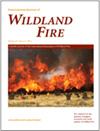Atmospheric turbulent structures and fire sweeps during shrub fires and implications for flaming zone behaviour
IF 2.9
3区 农林科学
Q1 FORESTRY
引用次数: 3
Abstract
Background Wildfires propagate through vegetation exhibiting complex spread patterns modulated by ambient atmospheric wind turbulence. Wind gusts at the fire-front extend and intensify flames causing direct convective heating towards unburnt fuels resulting in rapid acceleration of spread. Aims To characterise ambient and fire turbulence over gorse shrub and explore how this contributes to fire behaviour. Methods Six experimental burns were carried out in Rakaia, New Zealand under varying meteorological conditions. The ignition process ensured a fire-line propagating through dense gorse bush (1 m high). Two 30-m sonic anemometer towers measured turbulent wind velocity at six different levels above the ground. Visible imagery was captured by cameras mounted on uncrewed aerial vehicles at 200 m AGL. Key results Using wavelet decomposition, we identified different turbulent time scales that varied between 1 and 128 s relative to height above vegetation. Quadrant analysis identified statistical distributions of atmospheric sweeps (downbursts of turbulence towards vegetation) with sustained events emanating from above the vegetation canopy and impinging at the surface with time scales up to 10 s. Conclusions Image velocimetry enabled tracking of ‘fire sweeps’ and characterised for the first time their lifetime and dynamics in comparison with overlying atmospheric turbulent structures. Implications This methodology can provide a comprehensive toolkit when investigating coupled atmosphere–fire interactions.灌木火灾期间的大气湍流结构和火灾波及以及对燃烧区行为的影响
背景野火通过植被传播,表现出受环境大气风湍流调制的复杂蔓延模式。火线处的阵风延伸并加剧了火焰,导致对未燃烧燃料的直接对流加热,从而迅速加速蔓延。目的描述金雀花灌木周围的环境和火灾湍流,并探讨这对火灾行为的影响。方法在不同气象条件下,在新西兰拉卡亚进行6次烧伤实验。点火过程确保了火线穿过密集的金雀花灌木(1 m高)。两座30米的声波风速测量塔测量了地面上六个不同高度的湍流风速。可见图像是由安装在200米高空的无折叠飞行器上的摄像机拍摄的 m AGL。关键结果使用小波分解,我们确定了在1到128之间变化的不同湍流时间尺度 s相对于植被上方的高度。象限分析确定了大气扫掠(湍流向植被的下击)的统计分布,其中持续事件从植被冠层上方发出,并以高达10的时间尺度撞击地表 s.结论图像测速技术能够跟踪“火灾扫描”,并首次将其寿命和动力学特征与上覆大气湍流结构进行比较。含义该方法可以在研究大气-火灾耦合相互作用时提供一个全面的工具包。
本文章由计算机程序翻译,如有差异,请以英文原文为准。
求助全文
约1分钟内获得全文
求助全文
来源期刊
CiteScore
5.50
自引率
9.70%
发文量
67
审稿时长
12-24 weeks
期刊介绍:
International Journal of Wildland Fire publishes new and significant articles that advance basic and applied research concerning wildland fire. Published papers aim to assist in the understanding of the basic principles of fire as a process, its ecological impact at the stand level and the landscape level, modelling fire and its effects, as well as presenting information on how to effectively and efficiently manage fire. The journal has an international perspective, since wildland fire plays a major social, economic and ecological role around the globe.
The International Journal of Wildland Fire is published on behalf of the International Association of Wildland Fire.

 求助内容:
求助内容: 应助结果提醒方式:
应助结果提醒方式:


